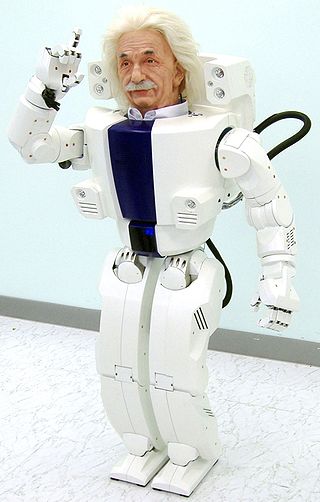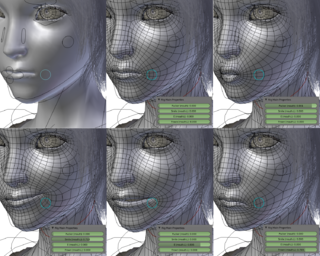
An android is a humanoid robot or other artificial being often made from a flesh-like material. Historically, androids were completely within the domain of science fiction and frequently seen in film and television, but advances in robot technology now allow the design of functional and realistic humanoid robots.
Telepresence refers to a set of technologies which allow a person to feel as if they were present, to give the appearance or effect of being present via telerobotics, at a place other than their true location.

In aesthetics, the uncanny valley is a hypothesized relation between an object's degree of resemblance to a human being and the emotional response to the object. Examples of the phenomenon exist among robotics, 3D computer animations and lifelike dolls. The rising prevalence of digital technologies has propagated discussions and citations of the "valley"; such conversation has enhanced the construct's verisimilitude. The uncanny valley hypothesis predicts that an entity appearing almost human will risk eliciting cold, eerie feelings in viewers.

HUBO is a walking humanoid robot, head mounted on a life-size walking bipedal frame, developed by the Korea Advanced Institute of Science and Technology (KAIST) and released on January 6, 2005. According to Hubo's creator Prof Jun-Ho Oh and his Plenary Session at ICRA 2012 entitled Development Outline of the Humanoid Robot: HUBO II the name Hubo is simply a name, not an abbreviation.

David Hanson Jr. is an American roboticist who is the founder and Chief Executive Officer (CEO) of Hanson Robotics, a Hong Kong-based robotics company founded in 2013.

Actroid is a type of android with strong visual human-likeness developed by Osaka University and manufactured by Kokoro Company Ltd.. It was first unveiled at the 2003 International Robot Exhibition in Tokyo, Japan. Several different versions of the product have been produced since then. In most cases, the robot's appearance has been modeled after an average young woman of Japanese descent.

Human image synthesis is technology that can be applied to make believable and even photorealistic renditions of human-likenesses, moving or still. It has effectively existed since the early 2000s. Many films using computer generated imagery have featured synthetic images of human-like characters digitally composited onto the real or other simulated film material. Towards the end of the 2010s deep learning artificial intelligence has been applied to synthesize images and video that look like humans, without need for human assistance, once the training phase has been completed, whereas the old school 7D-route required massive amounts of human work .

Albert HUBO is a humanoid robot, based on the HUBO, but with an animatronic head in the likeness of Albert Einstein. Introduced in 2005, Albert HUBO is the world's first walking humanoid robot with an android head. It was developed by Joon-Ho Oh of KAIST in conjunction with Hanson Robotics, who developed the head. Albert HUBO served as the ambassador of "DYNAMIC KOREA", an initiative by the government of South Korea to rebrand and promote its technology internationally. Albert HUBO is capable of making many facial expressions and interacting with people.
EveR is a series of female androids developed by a team of South Korean scientists from the Korea Institute of Industrial Technology in Korea University of Science and Technology. The project is headed by Baek Moon-hong and was unveiled to the public at the Kyoyuk MunHwa HoeKwan hotel in Seoul on May 4, 2003. The EveR name is derived from the combination of the Biblical "Eve" and the r from robot.

iCub is a one metre tall open source robotics humanoid robot testbed for research into human cognition and artificial intelligence.

Leonardo is a 2.5 foot social robot, the first created by the Personal Robots Group of the Massachusetts Institute of Technology. Its development is credited to Cynthia Breazeal. The body is by Stan Winston Studios, leaders in animatronics. Its body was completed in 2002. It was the most complex robot the studio had ever attempted as of 2001. Other contributors to the project include NevenVision, Inc., Toyota, NASA's Lyndon B. Johnson Space Center, and the Navy Research Lab. It was created to facilitate the study of human–robot interaction and collaboration. A DARPA Mobile Autonomous Robot Software (MARS) grant, Office of Naval Research Young Investigators Program grant, Digital Life, and Things that Think consortia have partially funded the project. The MIT Media Lab Robotic Life Group, who also studied Robonaut 1, set out to create a more sophisticated social-robot in Leonardo. They gave Leonardo a different visual tracking system and programs based on infant psychology that they hope will make for better human-robot collaboration. One of the goals of the project was to make it possible for untrained humans to interact with and teach the robot much more quickly with fewer repetitions. Leonardo was awarded a spot in Wired Magazine’s 50 Best Robots Ever list in 2006.

The HRP-4C, nicknamed Miim, is a feminine-looking humanoid robot created by the National Institute of Advanced Industrial Science and Technology (AIST), a Japanese research facility.
The Interactive Robots and Media Lab (IRML) is a research laboratory, originally hosted at the College of IT of the United Arab Emirates University in Al-Ain, Abu Dhabi Emirate, UAE, then moved on to the CSE facilities of New York University Abu Dhabi. Starting January 2013 IRML is expanding, emancipating, and partially commercializing its operations.
Nikolaos Mavridis is the founder and director of the Interactive Robots and Media Lab (IRML), and a PhD graduate from the Massachusetts Institute of Technology He is also an assistant professor of research at the Computer Science department, New York University Poly, and adjunct researcher at NCSR Demokritos. Before his PhD, he was awarded an M.Sc. from the University of California Los Angeles, and a M. Eng. from the Aristotle University of Thessaloniki. His research interests include human–robot interaction, and especially verbal and non-verbal communication with robots, artificial intelligence, machine perception, and cognitive systems.
The Telenoid R1 is a remote-controlled telepresence android created by Japanese roboticist Hiroshi Ishiguro. The R1 model, released in August 2010, is approximately 80 cm tall, weighs 5 kg and is made out of silicone rubber. The primary usage of the Telenoid R1 is an audio and movement transmitter through which people can relay messages over long distances. The purpose is for the user to feel as though they are communicating with a far-away acquaintance. Cameras and microphones capture the voice and movements of an operator which are projected through the Telenoid R1 to the user.

Nadine is a gynoid humanoid social robot that is modelled on Professor Nadia Magnenat Thalmann. The robot has a strong human-likeness with a natural-looking skin and hair and realistic hands. Nadine is a socially intelligent robot which returns a greeting, makes eye contact, and can remember all the conversations had with it. It is able to answer questions autonomously in several languages, simulate emotions both in gestures and facially, depending on the content of the interaction with the user. Nadine can recognise persons it has previously seen, and engage in flowing conversation. Nadine has been programmed with a "personality", in that its demeanour can change according to what is said to it. Nadine has a total of 27 degrees of freedom for facial expressions and upper body movements. With persons it has previously encountered, it remembers facts and events related to each person. It can assist people with special needs by reading stories, showing images, put on Skype sessions, send emails, and communicate with other members of the family. It can play the role of a receptionist in an office or be dedicated to be a personal coach.
Artificial empathy or computational empathy is the development of AI systems—such as companion robots or virtual agents—that can detect emotions and respond to them in an empathic way.

Sophia is a social humanoid robot developed by the Hong Kong-based company Hanson Robotics. Sophia was activated on February 14, 2016, and made its first public appearance in mid-March 2016 at South by Southwest (SXSW) in Austin, Texas, United States. Sophia is marketed as a "social robot" that can mimic social behavior and induce feelings of love in humans.
Hanson Robotics Limited is a Hong Kong-based engineering and robotics company founded by David Hanson, known for its development of human-like robots with artificial intelligence (AI) for consumer, entertainment, service, healthcare, and research applications. The robots include Albert HUBO, the first walking robot with human-like expressions; BINA48, an interactive humanoid robot bust; and Sophia, the world's first robot citizen. The company has 45 employees.
Engineered Arts is an English engineering, designer and manufacturer of humanoid robots based in Cornwall, England. It was founded in October 2004 by Will Jackson.










